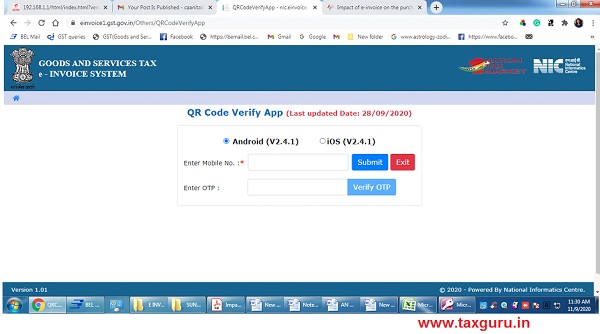1. The Government vides notification no. 61 /2020 CT- dated 30.07.2020 notified that a registered person with an aggregate turnover in a financial year exceeds rupees 500 corers is liable to generate e-invoice.
2. For e-invoice generation, notified suppliers to get their documents registered on the Government designated system i.e. Invoice Registration Portal (IRP). Once registered, IRP sends back a unique invoice reference number (IRN), a QR Code, and full invoice data, verified and digitally signed.
3. The invoice issued by the notified supplier without being registered at the IRP portal will be considered as an invalid invoice and Input Tax Credit is not available to the recipient on an invalid invoice. Thus, the consequences of non-compliance by the supplier will cost the recipient their ITC.
4. The question here is how the recipient will know if the supplier is covered under the e-invoicing mandate. NIC Portal has provided the way for a recipient to verify the enablement of the supplier and check the validity of the e-invoice issued by the supplier.
5. Steps to verify the status of the supplier covered under e-invoicing: The recipient needs to review the vendor master and identify the vendors with a turnover of 500 corers and above. Once identified, the status of those vendors can be verified on the NIC Portal. It is not required to register on the Portal and login for verifying the status of the supplier. One can check the status by entering the GSTIN of the supplier
5.1 Go to the e-invoice portal: http://einvoice1.gst.gov.in.
5.2 Click E-Invoice Status of Taxpayer on Search Tab.
5.3 On clicking E-invoice Status of Taxpayer, the following screen will be displayed. Enter the GSTIN Number of the supplier and it will show whether the supplier is enabled or not. With this verification process , the recipient will come to know that the enabled supplier is covered under the e-invoicing mandate.
6. At present, the GSTIN wise status verification mechanism is available on the NIC portal. Whereas, the turnover applicability is at the PAN level. Since GSTIN itself includes the PAN and hence check for one GSTIN could imply all GSTINs that belong to the PAN are also enabled
7. An e-invoice will be considered valid once an IRN is generated for the same. However, printing IRN on the invoice is not a mandatory requirement as QR code will have IRN Number embedded on it. Printing QR code on the final invoice is mandatory. Thus, when the taxpayer is on the receiving side of the invoice cycle, having a QR Code duly signed by IRP on an invoice will be necessary for him to claim ITC.
8. Verification of E-Invoice by the Recipient:- The e-invoice portal provides a facility / an App to the recipient or any third person to check the correctness/validity of e-invoice issued to them. The recipient can verify the authenticity or the correctness of the e-invoice by uploading the signed JSON file or Signed QR Code into the e-invoice system. The option ‘Verify Signed Invoice’ under the Search option can be selected and the signed JSON file can be uploaded and verified
9. Similarly, the QR Code Verify app may be downloaded and used to verify the QR Code printed on the Invoice. The App can be downloaded by clicking on Help/Tools/QR Code verify App.
10. E-Invoice can be scanned and verified from mobile with the downloaded App:-
11. Other Relevant Points
11.1 Scanning of QR code or uploading the signed data on the NIC portal are manual processes. There is no API available currently which can be used by the recipient or any other stakeholder, to verify the validity of the IRN. The Industry experts have suggested providing API which can help the recipients to automate their IRN verification process.
11.2. E-invoicing mandate covers Tax Invoice, Debit Note, and Credit Notes. Any other document issued by the supplier will not have IRN.
11.3 The feature (API) to get full invoice details by providing IRN can be triggered only by the supplier. The recipients cannot get the signed invoice data from the NIC system. Once the e-invoice data is pushed to GSTR 1, the recipients can obtain data from GSTR 2A.
11.4 The e-invoicing system allows e-commerce operators to generate IRN on behalf of suppliers. When transactions are made through e-commerce operators and E-Invoicing is done by e-commerce operators on behalf of the supplier, the QR code will contain the actual supplier’s GSTIN and not that of e-commerce operator.
11.5 There is a certain type of taxpayers and certain industries that have been given exemption from IRN generation. The recipient is required to be updated on such exemption notifications etc The recipient has to ensure that their internal systems and supplier masters identify SEZ Units and SEZ Developers as separate types as SEZ units are exempted from IRN whereas SEZ Developers are covered under e-invoicing
12. E-invoicing opens up many possibilities for taxpayers to automate their internal tasks and also have additional processes so that their ITC does not get impacted. The recipients need to revisit Supplier master periodically to know from which suppliers IRN is to be expected
____________
The Author can be approached at caanitabhadra@gmail.com











Supplier is providing only portal generated “E-invoice” (signed JSON QR code from IRP) alongwith their regular GST invoice. however regular GST invoice does not have a print of QR code.